| Reviews & Columns |
|
Reviews DVD TV on DVD Blu-ray 4K UHD International DVDs In Theaters Reviews by Studio Video Games Features Collector Series DVDs Easter Egg Database Interviews DVD Talk Radio Feature Articles Columns Anime Talk DVD Savant Horror DVDs The M.O.D. Squad Art House HD Talk Silent DVD
|
DVD Talk Forum |
|
|
| Resources |
|
DVD Price Search Customer Service #'s RCE Info Links |
|
Columns
|
|
|
Eclipse Series 31: Three Popular Films by Jean-Pierre Gorin
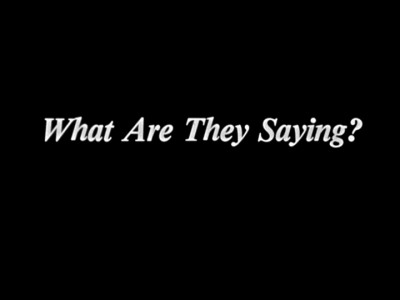
Prior to watching the three new-to-DVD discoveries excavated by Criterion for their Eclipse series box set Three Popular Films by Jean-Pierre Gorin, the only work by this expat French filmmaker/professor/writer I had seen was the 1972 feature Tout va bien and the accompanying short Letter to Jane, which Gorin made as a comrade of the legendary Jean-Luc Godard in their quasi-communal, experimental Dziga Vertov Group. Going only by what I'd been able to see of Gorin's output in those remarkable films, I was prepared for this trio--begun soon after Gorin's emigration from Paris to Southern California and comprising Poto and Cabengo (1980), Routine Pleasures (1986), and My Crasy Life (1992)--to be as playful, self-reflexive, heady, and in some measure political as they indeed turned out to be. More unexpected, though, is how explicitly personal these films are, particularly the first two. Part of the point of Gorin and Godard's Dziga Vertov co-authoring (when not simply unsigned) collaboration was a Marxist-inspired de-emphasis of the individual auteur and his cult of personality, making it difficult to tell whether Gorin or Godard (or another of their collaborators) was the "author" of this or that element of the film. But if Godard's individually-signed works are convincingly regarded as "essays" that are most often of the voraciously learned, reference-happy, far-reaching, third-person variety, these Gorin solo projects seem to belong more to the "personal essay" subgenre. They're explorations and ponderings that embrace and explicitly incorporate the fact that they frequently tell us as much about their author as they do about his subject(s), and as such have an unabashedly intimate, casual, first-person quality that offers an accessible yet not at all reductive or simplistic way into their themes and subjects.
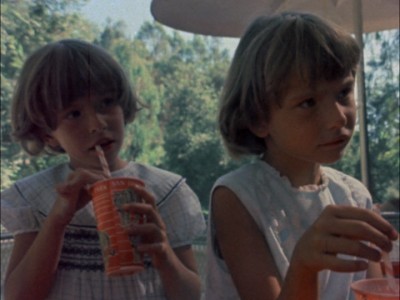
Poto and Cabengo was inspired by a news story that caught Gorin's eye not that long after he landed on these shores: a set of female twins born to a working-class San Diego couple and initially thought to be mentally handicapped had stunned speech therapists and linguists by apparently developing their own private language, understandable only between themselves (thus they are "Poto and Cabengo" to each other, though their given names are Virginia and Grace). Gorin arrives at the family's tenement dwelling with his 16 mm documentary filming setup, his voice-over narration explaining to us that matters of language and foreignness hold a natural fascination for him at least in part due to his own disoriented situation as an immigrant. As the media hubbub is progressively revealed to be oversimplified and inaccurate, Gorin turns to sources--the twins' therapists and counselors, linguistic experts, and, primarily, their parents and their grandmother--to explore the richer complexities underlying the situation. Their mother, Christine, is, like Gorin, an immigrant--a German who met and married her husband and the twins' father while he was stationed by the Air Force in Germany. Now, with her husband a struggling real-estate agent, she has settled the family in San Diego and moved her non-English-speaking mother in from Germany to aid with child-rearing and housekeeping duties, creating a unique linguistic environment that, in addition to the parents' medically-reinforced assumptions about the "delayed" twins's suitability for socializing, surely has something to do with their creating what sounds like a new language for themselves.
What came to Gorin's attention as an odd little human-interest item becomes, when transfigured by his restless, persistent inquisitiveness and freewheeling, imaginative aesthetic approach (which expands his documentation out with intertitles, photo montages of pre-WWI Germans, and details from Katzenjammer Kids cartoons and newspaper headlines, along with his frequently amusing, self-deprecating voice-over musings), a cinematic hybrid to match the twins' creative mixing and matching, encompassing elements of sociology, history, immigrant testimonial, and linguistic investigation to create an astute yet poignant collage whose overarching theme is nothing less than the obliquities and eccentricities of the American dream.
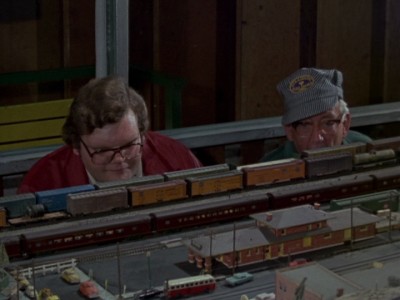
Routine Pleasures again features Gorin's wry voice-overs, here positing himself as both restless, somewhat hapless cinematic instigator and the point at which the film's seemingly incongruous subjects--a very dedicated group of middle-aged male model train enthusiasts and the great American film critic and painter Manny Farber--converge. Both the two brightly colored, feverish and jam-packed Farber paintings--1979's Birthplace: Douglas, Arizona and 1982's Have a Chew on Me--that appear before Gorin's camera in lieu of the cantankerous and unsurprisingly camera-averse Farber himself (his withering critiques, comments, and advice to Gorin are related to us by the filmmaker) and the minute, often Marwencol-like details that the model railway hobbyists include in their elaborate, technically astonishing set-ups are work that represent, for their makers, what Gorin terms "obsession and pleasure." (When, after painstaking preparation, the guys finally get to put their trains into action, Gorin gives us a lovely switch from black and white to color that belies any notion of that Wizard of Oz device ever losing its charm, so long as it's aptly deployed). For the filmmaker himself, frustrated by his American film students' indifference to the William Wellman and Samuel Fuller films he shows them in an attempt to open their eyes to the wealth of their cinematic heritage, Routine Pleasures began as his version of "something Howard Hawks would make," with its characters (the genial and focused model railroaders) involved in camaraderie and common pursuit. But it ends up being two contrasting windows for Gorin--and three for us, as we're also looking through Gorin's own quixotic yearning for a bygone America--into Americans' relationships with and ways of revisiting or reiterating the past. Sections detailing Farber's paintings and his stoical rejection of and contempt for nostalgia are alternated with those dedicated to the model railway aficionados for an initially contrasting but increasingly connected, sometimes even overlapping back-and-forth/point-counterpoint structure that vividly conveys two distinct modes of response (deep suspicion and full immersion) to the pervasive, romantic backward-looking longing that defined the height of the Reagan era and gave birth to the modern American Right.
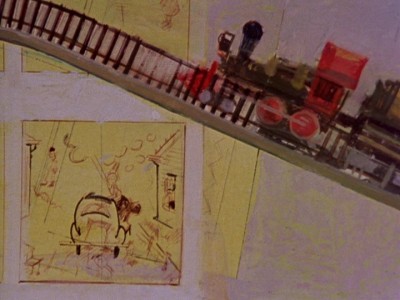
My Crasy Life is a very different beast than the other two films. Gorin's direct presence in front of the camera and/or on the soundtrack is gone; instead, we have a ingeniously discombobulating fiction/documentary hybrid centering on a group of Samoan gangbangers in Long Beach, California and the policeman (Jerry Kaono) who tries to understand and help them. The officer is aided by his police car's onboard computer, which, like some wise-ass HAL, taunts him about his ability to do either, self-reflexively undermining any presumptions that the truly good, kind-hearted sergeant, we the viewers, or Gorin--all outsiders--may have about our position vis-à-vis these marginalized and (as several jarring photo montages of dead, bloodied gang members drives home) endangered subjects while "studying" them from our respective positions of authority, from behind the camera, and on our sofas at home. (The effect of the computer's officious monotone as the film's conscience/inner voice is both funny and quite effectively disconcerting.) Even so, the subjects--all actual gang members with whom Gorin is collaborating--do their best, through interviews and reenactments and with all bravado and rap-star aspirations in full force, to represent themselves, what their lives are like and what they care about, if not explain (do they owe us an explanation?) "why" their fierce, violent loyalty to their homies is as central to their existence as it clearly is.
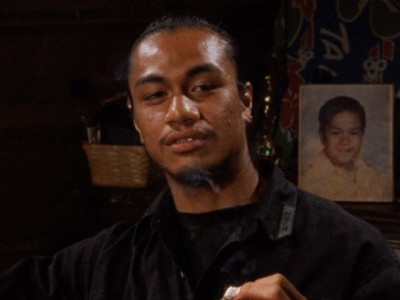
Into these fraught, tense proceedings, with their omnipresent and nonchalantly accepted threat of aggression and violence, Gorin intercuts footage of Kaono traveling to Honolulu to track down the estranged family of one gang member in particular that he's trying to rescue, along with glimpses of American Samoa and one gang member's return visit to this island whose people and traditions its ghetto-trapped children are so far removed from (with any threat of treacle cut by a vibrant, vulgar, slang-saturated reminder that paradise-lost romanticism does nothing to address the harsh reality facing the Long Beach Samoan gangs). What keeps My Crasy Life continuous with the other films despite its very noticeable differences is Gorin's persistent interest, as a stranger in a strange land, both in the experiences of people whose "home" is in another place or time and who are now making a go of it in the strange here-and-now U.S., and in the particular phenomena and preoccupations of American life. (One cannot forget that this film was made in 1992, the year of the Rodney King verdict and the L.A. riots, at the height of America's panic and paranoia over the growing, increasingly violent gang activity flourishing in its desperate ghettoes.)
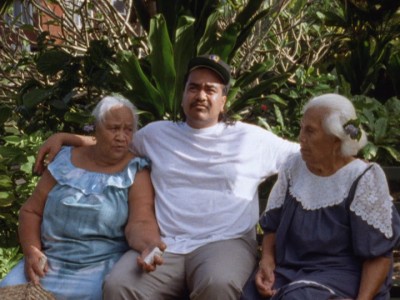
Each of the entries in Three Popular Films by Jean-Pierre Gorin is a highly original, ingeniously posed question that the filmmaker is posing to both himself and to us, with answers proposed or not (the clever use of onscreen question marks and the repetitive interposition of the intertitled phrase "What are they saying?" in Poto and Cabengo dissipates as what they're saying is eventually deciphered, but by then the film's mystery seems to extend far beyond that) but never decisively arrived at. The film's don't presume to boil things down or offer solutions to their riddles, but they ask their questions in such an endlessly interesting, engaged, good-faith and down-to-earth manner, and with such witty, inventive use on Gorin's part of his cinematic resources and the documentary form, that it seems not only acceptable but entirely satisfactory (not to mention in keeping with Gorin's genuinely inquisitive, intelligent, sincerely empathetic sensibility) that those questions should remain open.
THE DVDs:
Each of the films is presented at the correct 1.33:1 aspect ratio in a transfer that is nearly 100% free of visible defects yet retains the distinctive, rawer textures and properties of Gorin's old-fashioned-documentary 16 mm, often handheld shooting style (the second two with remarkably vivid cinematography by Babette Mangold, who shot Chantal Akerman's Jeanne Dielman).
Sound:Each of the films is presented with a Dolby Digital 1.0 mono soundtrack, reflecting how the films were originally made and perfectly adequate, both technically and aesthetically, to fully conveying all of the nuance and layers of their direct and post-dubbed (voice-over) sound. Some limitations to the direct-sound process are evident in some scenes, for example containing small talk between the model railroaders in Routine Pleasures, but Gorin obviously accounted for this, and we hear everything we need to. Otherwise, absolutely no distortions or imbalances in sound due to the transfer/mastering process were detectable.
Extras:Most Eclipse series are intentionally bare-bones presentations with no extras, but fans (like me) of critic Kent Jones will certainly consider his special guest appearance as the writer of the set's liner notes an "extra," as the written accompaniments that give context to entries in the Eclipse series are usually written (and written well, I should add, just not with Jones's particular erudition and perception) by Criterion's house scribes.
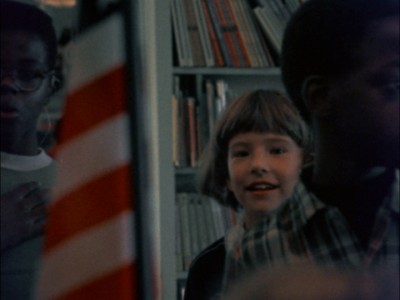
The unusually winding path of director Jeanne-Pierre Gorin's career brought him from Paris and a collaboration with Godard to Southern California, academia, and rarer forays into filmmaking itself. Watching the results of Gorin's labors in Three Popular Films by Jean-Pierre Gorin makes that last bit seem highly regrettable; his resourcefully articulate, curious voice has something unique to offer, and one wishes it could be brought to bear on yet more seemingly mundane or inscrutable oddities and disturbances in "normal" life like the ones he approaches so incisively (yet with such caution, open-mindedness, and respect) here. Gorin has a way of carefully and elliptically unpacking (and continuing to unpack, with no intention of exhausting) the subjects he chooses, and although these films are entirely unpretentious and lacking in any obvious sense of striven-for gravity or self-seriousness, their insistence on treating the problems and mysteries at their center as continuingly fruitful points of departure, not just puzzles to be solved and put away, gives them a surprising, haunting staying power. Highly Recommended.
|
| Popular Reviews |
| Sponsored Links |
|
|
| Sponsored Links |
|
|
| Release List | Reviews | Shop | Newsletter | Forum | DVD Giveaways | Blu-Ray | Advertise |
|
Copyright 2024 DVDTalk.com All Rights Reserved. Legal Info, Privacy Policy, Terms of Use,
Manage Preferences,
Your Privacy Choices | |||||||













